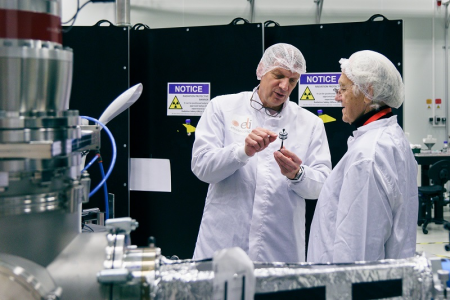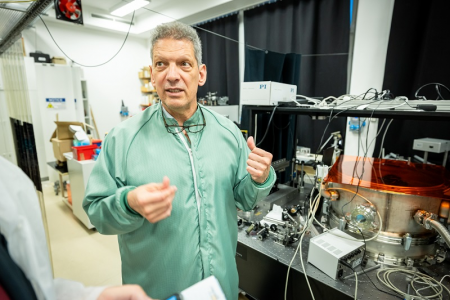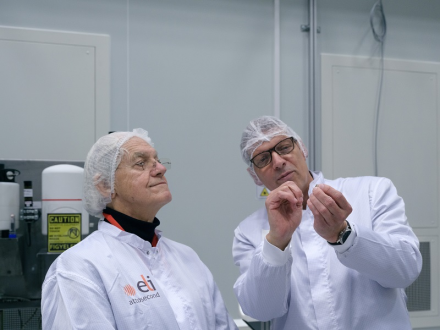
The National Laser-Initiated Transmutation Laboratory at the University of Szeged, led by physicist Dr. Károly Osvay and supported by his research team, has achieved a groundbreaking global first by demonstrating the feasibility of continuous neutron generation using a low-energy, short-pulse laser. Through meticulous scientific and technical innovation, the laboratory has set a world record, generating 108 neutrons per second. The laboratory’s neutron-generation beamline is now a key component of the ELI ERIC user program, positioning it at the forefront of pioneering research in radiobiology and medical isotope production. To mark the conclusion of the transmutation project’s initial phase, an international conference was held on February 7, 2025, at the ELI ALPS Laser Research Center in Szeged. Ahead of the event, we interviewed Dr. Osvay, who reflected on the groundbreaking five-year journey of laser transmutation research.
Q: In the laser transmutation research program, you’ve constructed a cutting-edge laser-based neutron beamline from the ground up. What is the primary goal of this project, and why is ‘transmutation’ a key element of its title?
A: Initiated by a government decree in March 2019, the transmutation research program plays a crucial role in managing nuclear energy byproducts, aligning with Hungary’s commitment to this source of energy. The core principle of the transmutation process is that, by harnessing a suitable neutron source, we can develop a mechanism that transforms long-lived isotopes in spent fuel into isotopes with significantly shorter half-lives. This is important because, under current international regulations, each country is responsible for managing its radioactive waste, including spent nuclear fuel. Among Hungary’s storage facilities, the one in Püspökszilágy is nearing capacity, leaving primarily the Bátaapáti facility designated for low- and intermediate-level waste. Preparations are also underway for the placement of highly radioactive waste, including spent fuel elements, within Hungary. However, storage facilities must be designed to ensure safety throughout their radiation period, which could last between 200,000 to 300,000 years. Through transmutation, this lengthy duration can be reduced to just a few hundred – or at most, a thousand – years. This makes it feasible to design such storage facilities, typically located underground, as we know that many human-made structures have already withstood the test of time for thousands of years.
Q: Why were lasers necessary for neutron generation when neutrons are also released during nuclear processes as well?
A: According to one approach proposed by researchers working on transmutation, long-lived isotopes could be treated in a so-called subcritical reactor, which relies on an external neutron source and operates only as long as this source remains active. Although nuclear reactions within the reactor generate a substantial number of neutrons, they are insufficient to sustain the reaction independently. This makes subcritical reactors inherently safer and guarantees that they cannot enter a runaway state. However, if the neutron source is absent for just five minutes, the entire system shuts down, which, while ensuring safety, creates a major challenge for industrial applications, as restarting the reactor takes two to three days – an impractical delay for industrial production. This is where lasers come into play, as existing technologies like linear accelerators and cyclotrons can serve as external neutron sources and are widely used in scientific and industrial settings. Then again, their operational downtimes raise concerns about economic feasibility: although they typically guarantee around 95% uptime, outages lasting more than five minutes occur weekly or biweekly. To address this issue, laser-based neutron production offers a far more reliable alternative, since deploying a sufficient number of lasers can boost uptime to over 99%, ensuring an industrially and economically stable neutron source. It was this critical need for greater reliability that drove the development of a laser-based neutron source, a project we initiated five years ago.

Physicist Károly Osvay (Department of Optics and Quantum Electronics, University of Szeged) in the company of Nobel laureate Gérard Mourou at ELI ALPS
Photo by Gábor Balázs
Q: How can neutrons be generated using lasers?
A: In the first phase of our experimental series, our research team at ELI investigated how short-pulse lasers can accelerate particles, ultimately leading to neutron generation. Neutrons are produced by directing a laser beam onto a suitable target, such as a foil, which creates plasma. The laser, as an electromagnetic wave, interacts with the charged particles within the plasma. Similar to how older television sets functioned as particle accelerators – where an electron beam struck the screen – lasers can accelerate charged particles to significant energies over just a few tens of micrometers. The charged particles from the first target then collide with a second target, where their energy levels can trigger nuclear reactions that generate neutrons. This fundamental phenomenon was first demonstrated experimentally in the 1980s using the most powerful long-duration laser pulses of that time, which extended over several meters.
Nobel laureate Gérard Mourou – now a research professor at the University of Szeged and a speaker at our conference – along with plasma physicist Professor Toshiki Tajima, proposed an alternative approach. They suggested using relatively low-energy yet extremely short and spatially condensed pulses, with thicknesses as small as one-tenth of a human hair. While this method offers stability, its industrial applicability faces a key challenge: the cost-benefit ratio. For the system to be viable, it must be highly efficient. According to Mourou and Tajima’s original calculations, short-pulse lasers have the potential to achieve particle acceleration efficiencies of 40-50 percent.
Q: When you started, did you have to rely solely on simulations due to the lack of experimental results?
A: We had no prior data on the actual efficiency of acceleration using short-pulse lasers, as no experiments had been conducted with lasers as short-pulsed as those at ELI. Initially, there were doubts among professionals about whether acceleration could even be achieved with such low-energy lasers. However, we have demonstrated that it is indeed possible and have systematically mapped the physics of this acceleration through a series of experiments, ultimately leading to neutron generation.
At first, we produced only a few hundred neutrons per laser shot per second, which we gradually increased to over a thousand and eventually to over ten thousand. We ultimately achieved not only tens of thousands of neutrons per shot but also significantly increased the total number of shots. We started with a repetition frequency of 10 Hz – firing ten shots per second – but by this time last year, we had reached 1,000 shots per second, resulting in a neutron yield of 10⁸ neutrons per second, a figure that can be considered a world record in itself.
At that stage, we could sustain this result only for a few seconds because our primary target, where acceleration occurs, was not stable at that repetition frequency. However, after nearly a year of work on improving stability, the system is now functioning properly.
Q: Did this process also involve a series of technical innovations? What are the key components of the equipment used for neutron generation?
A: While accelerating particles with lasers, we observed that plasma is generated, but the target foil at the impact site breaks through, requiring replacement before the next shot. Initially, we addressed this issue by using a rotating disk that shifted slightly with each shot. However, since the disk surface is finite, frequent replacements became a challenge.
In 2023, we developed a liquid jet target by directing two opposing liquid jets at each other, forming a thin liquid film in the plane where they intersect. This film serves as our target. The entire setup is compact, with the liquid film measuring about 1.5 mm in height and just under 1 mm in width, shaped somewhat like a spear – though some liken it to a heart.
Similar liquid jet configurations have been used in chemistry and biology, particularly in liquid chromatography, which typically operates in an air environment. However, our experiment takes place in a vacuum, as accelerated particles are quickly absorbed in air. Since the liquid film is only a few hundred nanometers thick, the entire system operates within a vacuum chamber.
A key challenge arises when the liquid enters a vacuum, as it immediately boils and evaporates, disrupting the vacuum and causing heat loss, which can lead to freezing. To counteract this, the liquid must be continuously circulated, and additional conditions must be maintained within the vacuum to ensure stability. The dynamics of the liquid jet are complex – even minor vibrations in the lab can destabilize it, much like how a swing can gain excessive motion if pushed at just the right frequency. A similar effect occurs here: each incoming laser pulse transfers energy to the liquid film, and over time, resonance can develop, making the film unstable around its resonance frequency.
Our first successful experiment at 10 Hz, where we achieved continuous firing, took place in the summer of 2023 and was considered a major milestone.

Károly Osvay at the Laser Laboratory of the Institute of Physics, University of Szeged
Photo by Ádám Kovács-Jerney
Q: What was the impact of ramping up the number of shots?
A: When we increased the repetition frequency to 1,000 Hz last year, we encountered instability that had not been present at 10 Hz. The liquid film became unstable and froze within minutes, requiring us to redesign its mechanics and controls. To address this, we developed an external laser-based position stabilization unit that continuously measures the beam’s position and corrects it using specific actuators.
Over the past three-quarters of a year, we have made significant adjustments to maintain the liquid film’s stability. We can now keep it within plus or minus one and a half degrees at any repetition frequency – our most recent achievement. This level of precision ensures that the ion beam produced by the liquid reaches the neutron converter, positioned approximately 18 centimeters away, effectively generating neutrons.
We are particularly proud of this milestone. Our technical designs have already led to publications, and we are currently preparing articles for international scientific journals to share our findings. Additionally, we have submitted two patents – one for optimizing deuterium acceleration and another for stabilizing the liquid film.
Q: How do you keep the neutron yield of 108 per second stable over extended periods?
A: We have observed that when the neutron yield reaches approximately 10⁸ per second, it gradually declines to about a quarter or a fifth of its initial value over one to two hours. This reduction is due to the surface of the neutron converter burning and obstructing further deuteron penetration.
To mitigate this, we implemented a disk-based solution by placing deuterium converter strips on a rotating wheel, which turns at an optimized speed to evenly distribute surface damage. However, after about two hours, the wheel still requires replacement.
To achieve longer continuous operation, we are currently developing a renewable, likely liquid-based target to replace the neutron-generating unit. This approach is expected to eliminate thermal degradation issues and enable uninterrupted operation for up to 24 hours.
Q: While staying grounded in reality, you often point out that practical transmutation solutions will take time to develop. However, medical and biological applications are already within reach.
A: From the outset, the national laboratory’s program has included radiobiological experiments using laser-generated neutrons. Professor Katalin Hideghéty, head of the Radiation Therapy Unit at the University of Szeged’s Department of Oncotherapy, along with the leader of the ELI research group on medical applications and their colleagues, has already conducted two experimental campaigns. The findings will be presented in two talks at the upcoming Szeged conference.
During the final experimental week in November 2024, we delivered over 1.5 gray of neutron radiation per irradiation to biological targets. While evaluations are still ongoing, we have already observed a significant impact on DNA double-strand breaks and the behavior of the experimental zebrafish embryos.

Gérard Mourou and Károly Osvay at ELI ALPS
Photo by Gábor Balázs
Q: The conference program includes a presentation on the production of medical isotopes. Could this lead to potential applications as well?
A: The neutron source developed by our researchers at the University of Szeged is currently operational at ELI, and this beamline has been featured in ELI’s latest user program. Out of 55 submitted research projects, five are set to conduct experiments using this neutron source.
As part of this initiative, we will carry out a proof-of-principle experimental campaign in collaboration with an international consortium led by an Australian university. The goal is to explore whether neutron generation via lasers can be applied to medical isotope production and to evaluate the efficiency of this approach, which involves several complex steps that we aim to demonstrate experimentally.
A few years ago, we began investigating the feasibility of producing medical isotopes in collaboration with researchers from the Institute for Nuclear Research (ATOMKI) in Debrecen, including Zoltán Elekes and Zsolt Fülöp, as well as Mihály Veres from Isotoptech Zrt., a Debrecen-based company specializing in technical research and development. Simulations for this project have already been conducted, and simultaneously, the international consortium led by our Australian partner has applied to participate in the ELI user program.
Q: What other applications do you anticipate?
A: Along the way, it has become evident that our ion acceleration results are significant in their own right. Using a laser with a repetition frequency of 1 kHz, we can generate an ion beam with an average power of 4 watts emerging from the liquid film – powerful enough to be used even for cutting applications.
Another intriguing and highly beneficial application could be testing electronic devices for space technology. The conditions in outer space – characterized by strong gamma, ion, and neutron radiation, along with a vacuum – closely resemble those within our experimental chamber. Until now, electronic devices intended for space have primarily been tested for their ability to withstand individual effects. However, in our interaction chamber, we could assess their resilience against nearly all relevant factors simultaneously.
Q: What are the ambitious goals set for the transmutation project over the next five years?
A: First of all, I am pleased to say that we have successfully met all the targets established for the initial phase by creating a one-of-a-kind laser neutron source capable of continuously producing neutrons at an impressive rate of 10⁸ per second. Although the yield fluctuates slightly due to the burning of the neutron converter, this issue can be mitigated. Moreover, a higher-powered laser could achieve an order-of-magnitude improvement, as increasing laser power proportionally enhances neutron yield.
As a result, we now have a neutron source suitable for pilot studies across various fields, including applications in living systems, isotope production, and astrophysics – an achievement that is sure to attract international interest for years to come. Looking ahead, our goal for the next five years is to develop a source capable of generating over 10¹⁰ neutrons per second, opening new possibilities for further industrial and biological applications.
Original Hungarian text by Sándor Panek
Feature photo: Dr. Károly Osvay, physicist and head of professional affairs at the National Laser-Initiated Transmutation Laboratory
Photo by Ádám Kovács-Jerney

